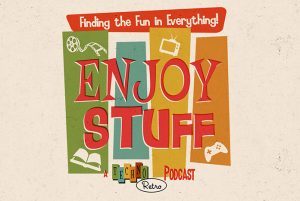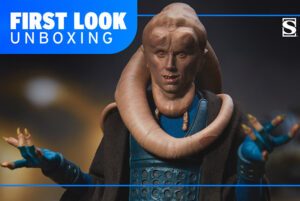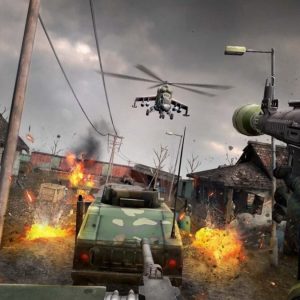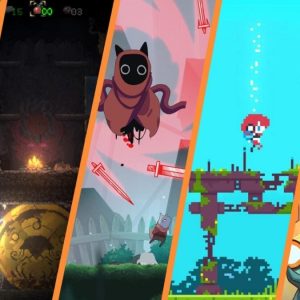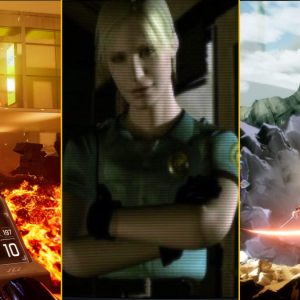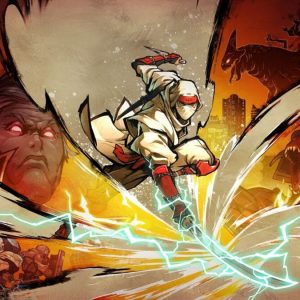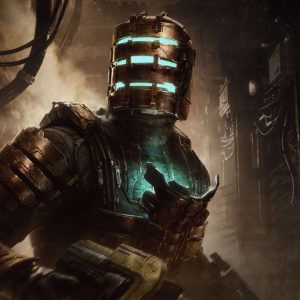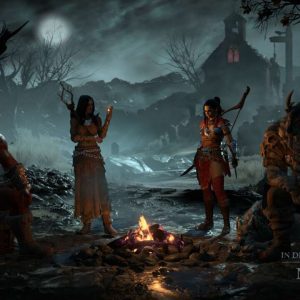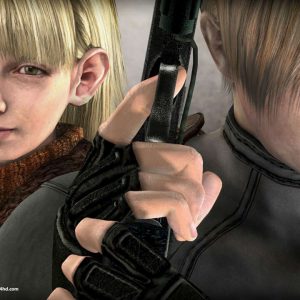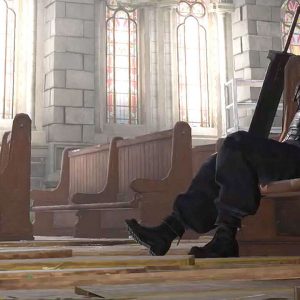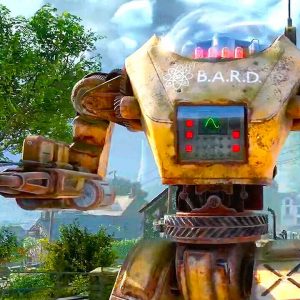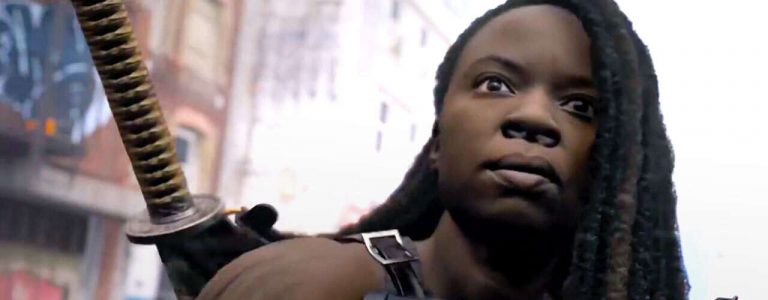This article contains spoilers for the Until Dawn movie.
I’ve been racking my brain over the conundrum that is adapting Until Dawn. Supermassive Games’ deconstruction of horror cinema through choice-based butterfly effect mechanics is essentially a 10-hour playable movie—a damn fine one written by indie horror staples Larry Fessenden and Graham Reznick—so a film adaptation couldn’t just be the same thing. But a film that isn’t indebted to the game and its “choose your own adventure” method doesn’t feel appropriate either. Sony’s desire to release an Until Dawn adaptation seemed misguided upon announcement, and after viewing the film, it’s still a headscratcher.
That’s because David F. Sandberg’s Until Dawn movie betrays the core hook of Supermassive’s Until Dawn.
Writers Gary Dauberman and Blair Butler chose to adapt Until Dawn as its title reads. In this case, “Until Dawn” translates into a time-loop-like horror scenario where five young adults find themselves hunted by various baddies, and they only escape if they can survive … until dawn. Should anyone die, they’ll wake once a gigantic hourglass fixed to an ominous, skull-adorned mount drops its last grain of sand. Die enough times, and you become a wendigo lost to Dr. Alan J. Hill’s delirious experiment. The core impetus of a missing sibling is still there—Ella Rubin’s protagonist, Clover, is hunting for her missing sister—but otherwise, you’re not on Blackwood Mountain aka Mount Washington (er…yet), and certainly not similarly punished for choices that alter narrative paths.
That’s… not Until Dawn.
Death Shouldn’t Be An Afterthought
In the game, death matters. It matters so much, in fact, that killing a single character sends ripple effects felt throughout the remaining storylines. There’s no regeneration or second chances. Like, famously. That’s the point of Until Dawn. The stakes are so astronomically high, the slightest nervous twitch of your controller during a “stay still” Quicktime event could doom multiple characters. Dauberman and Butler fail to translate the nerve-wracking experience of playing Until Dawn, landing on quite the opposite concept.
If anything, Until Dawn is a beginner’s attempt at Cabin in the Woods. Glore Valley is drenched by a thunderstorm, except for a perfect circle of sunshine over the welcome center location, like some all-powerful horror movie god is controlling the rain—once again resembling Cabin in the Woods in terms of the “influencing environment” effect. The all-seeing overlord (Dr. Hill), the meta nature of characters joking about horror movie rules, and the different creatures unleashed each rewind? Despite countless plot configurations, the game’s powerful storytelling is far superior to this random assortment of scary scenes tied to an hourglass clock. The game pulls players deeper into a web of intrigue, where the movie’s Mad Libs nature drags viewers through a jumbled rotation of clowns-and-kooks randomness.
Points are awarded for at least using wendigos. In the game, Fessenden’s “Stranger” character reveals that a 1952 mining cave-in led to cannibalism, and said cannibals turned into wendigos that now haunt Blackwood. Here, Clover and her friends start turning into wendigos due to Dr. Hill’s experiments on Glore Valley from his sanatorium hideout (resembling his dingy in-game office). It’s not a one-for-one translation, nor does it need to be, but the wendigos are overshadowed by a slasher villain vaguely costumed after Josh’s psycho getup. There are also witches, porcelain doll-looking masks, creepypasta demons, and water that makes your entire body explode Scanners-style if you drink it. It’s a hodgepodge of dangers that have nothing to do with Fessenden and Reznick’s straightforward creature-centric game, outside of a few Easter eggs.
The most obvious connection is Peter Stormare as Dr. Hill, Josh Washington’s (Rami Malek) hallucinated psychiatrist who runs players through rigorous psychological tests that influence future in-game details. However, even Dr. Hill features stark differences in the film vs. the original game. In the movie, he’s seen as a gas station attendant, but it’s not long before he’s outed as former game character Dr. Hill—who’s in control of experiments on Glore Valley. It’s here where we have the only direct reference to the game’s most well-known character, Josh Washington. After Clover discovers Hill’s “office,” we see her patient profile alongside Josh’s.
There’s some exposition about Hill’s experiments as we watch prisoners cannibalize bodies and then turn into wendigos to highlight that connection to the game, but the reveal is followed by Clover defeating Dr. Hill pretty easily.
Except she doesn’t. Probably.
As the film ends, we return to the dirty sanitarium office where Dr. Hill explodes after ingesting some ‘splodey water, and on surveillance monitors, we see Blackwood’s lodge. We then hear Dr. Hill speak, suggesting he was Clover’s hallucination, much like Josh’s in the game. But, that’s right before the credits because I guess Sandberg’s movie is an offshoot prequel that, for some reason, has nothing to do with the actual events of the Until Dawn game? If there is a sequel, presumably it’ll be about Josh’s case of vengeance paid unto the Blackwood group except based on the film’s rules … somehow.
Cheap Easter Eggs Aren’t Enough
It’s just all so generic. Turning Dr. Hill into the baddie removes intrigue and becomes a cheap cop-out, torn from the game but improperly refitted. Then the stinger of Blackwood hits, which again is confusing because in interviews, Sandberg insists his film takes place after the game’s timeline—but Blackwood’s reveal suggests it’s not a sequel, but a prequel. Inconsequentiality plagues Sandberg’s film in a way that makes you wonder why it’s even tied to Until Dawn (*cough* intellectual property reasons *cough*), which only causes Blackwood’s tease to be even more spoonfed and underwhelming. For so long, Until Dawn (the movie) bears no resemblance to Until Dawn (the game)—why pivot back toward the game at the last minute?
The reason is simple: to appease us fans. There are choice moments that attempt to help us relive the game, but they’re crammed in like afterthoughts. Ji-young Yoo’s spiritualist character Megan has everyone hold hands in silence, mimicking the game’s quiet “hold your breath” Quicktime events. There’s a shot bathed in red lighting where a wendigo is right by a frightened Clover, and that’s a direct reference to the “Don’t Move” instructions. But the game’s cinematic nature doesn’t yield many other level-based opportunities to recreate, nor does the film try. The adaptation’s biggest issue is it never fully comprehends how best to honor Supermassive’s inspiration while telling a fresh horror tale.
What else might you recognize? The wendigo audio files are plucked from the game, reusing the same noises. There’s also Abe’s first death of being chopped in half, which could be respect paid to Josh’s fake death in the game, or maybe that’s just a lucky coincidence. Are the werewolf sketches in the witch’s cabin a possible reference to The Quarry? Is the radio in the basement the same radio in the game where characters find out they must survive until dawn? Chances are yes, but these Easter eggs feel forced.
Look, I’m all for a “spiritual successor.” But to do so, there has to be some resemblance to the thing you are named after. While I don’t think Until Dawn is a terrible movie, it’s a bad Until Dawn movie. It’s a far cry from the urgency and invasive dread that Supermassive so easily conjures, speaking to what makes the playable horror movie such a blast to complete (over and over).
As is, the Until Dawn movie doesn’t make much sense in context. The events of Glore Valley are a grab bag of ideas from other horror movies that would be nothing but a clip show without Dr. Hill’s inclusion. But even with Stormare’s reprised role, it’s only Until Dawn at face value, nothing deeper. I get the interpretation of the gang’s choices forcing them to keep restarting, but it’s still too far off-base to consider this adaptation anything more than unfaithful. In the end, Until Dawn is a missed opportunity to bring Supermassive’s smash-hit game to life.


